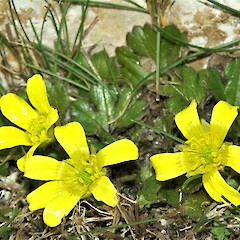Ranunculus callianthus
Synonyms
None - first described in 2019
Family
Ranunculaceae
Flora category
Vascular – Native
Endemic taxon
Yes
Endemic genus
No
Endemic family
No
Structural class
Herbs - Dicotyledons other than Composites
Chromosome number
2n -= 48
Current conservation status
The conservation status of all known New Zealand vascular plant taxa at the rank of species and below were reassessed in 2017 using the New Zealand Threat Classification System (NZTCS) – more information about this can be found on the NZTCS website. This report includes a statistical summary and brief notes on changes since 2012 and replaces all previous NZTCS lists for vascular plants.
Please note, threat classifications are often suggested by authors when publications fall between NZTCS assessment periods – an interim threat classification status has not been assessed by the NZTCS panel.
- Conservation status of New Zealand indigenous vascular plants, 2017 . 2018. Peter J. de Lange, Jeremy R. Rolfe, John W. Barkla, Shannel P. Courtney, Paul D. Champion, Leon R. Perrie, Sarah M. Beadel, Kerry A. Ford, Ilse Breitwieser, Ines Schönberger, Rowan Hindmarsh-Walls, Peter B. Heenan and Kate Ladley. Department of Conservation. Source: NZTCS and licensed by DOC for reuse under the Creative Commons Attribution 4.0 International licence.
2017 | Threatened – Nationally Critical | Qualifiers: OL
Brief description
A limestone inhabiting buttercup similar to the Stewart Island/Rakiura endemic Ranunculus stylosus, from which it differs by its more robust growth habit, larger leaves, petiole and peduncle with patent and white hairs, larger flower and petals, abaxial surface of the sepals and petals pale yellow, more stamens and carpels per flower, bifid nectary scale, and by the achene which has a strongly curved beak.
Distribution
Endemic. New Zealand: South Island (South Canterbury: Tengawai River, near Albury).
Habitat
Confined to limestone outcrops.
Detailed description
Rosettes single or forming compact patches comprising several tightly placed rosettes, appressed to the ground in exposed sites but taller in the shelter of rocks and other vegetation. Lamina 10–28 × 8–26 mm, broad rhomboid, rhomboid or orbicular-deltoid, glossy, coriaceous, stiff, dark green, black-brown on proximal veins and at sinus lobe; 3–(5)-lobed, often to about halfway across lamina, adaxial and abaxial surfaces sparsely to moderately hairy with shaggy, loosely appressed white hairs, hairs up to 1.8 mm long; base cuneate to obtuse; margin crenate or serrate, sparsely to moderately hairy; apex of main and lateral lobes subacute, with white hydathode an abaxial surface. Petioles 10–70 mm long, green, dark-mottled hairs patent and sparse to dense; basal sheath broad, membranous, glabrous to sparsely hairy, entire, margin sometimes sparsely hairy. Peduncle 15–140 mm long, up to 3 mm diameter, spreading to ascending, strongly recurved in fruit; dark green and dark-mottled throughout, hairs moderate to dense, patent, white; bracts usually absent, sometimes or 1–2 simple narrow bracts. Flowers 1–(2), 21–30 mm diam. Sepals 5, 5.5–10.0 × 2.5–4.0 mm, yellow-green, caducous, abaxial surface sparsely to moderately hairy, adaxial surface glabrous, margin translucent, apex obtuse. Petals 5, 11.0–15.0 × 5.0–7.5 mm, obovate-oblong, glossy, yellow with yellow-brown basal blotch above, pale yellow below. Nectary c. 1.0 mm from base of petal; scale c. 1.0 mm long, oblong or broad-oblong, apex bifid. Stamens 28–38; filaments 2.0–4.0 mm long, white; anthers 1.3–1.8 mm long, yellow; receptacle sparsely to moderately hairy; carpels 11–20, 3.0–4.0 mm long. Achenes 11–20, yellow-brown with red to red-black blotches, 4.5–6.5 mm long, ellipsoid, lateral faces compressed; body 3.0–3.5 × 2.0–2.7 mm; beak strongly curved, 1.6–3.0 mm long.
Similar taxa
Ranunculus callianthus is most similar to the Stewart Island/Rakiura endemic R. stylosus. From that species Ranunculus callianthus differs by its more robust growth habit, larger leaves, petiole and peduncle with patent and white hairs, larger flower and petals, abaxial surface of the sepals and petals pale yellow, more stamens and carpels/achenes per flower, nectary scale with bifid apex, and the achene with a strongly curved beak. Ranunculus callianthus also has 2n = 48 chromosomes whereas R. stylosus has 2n = 32. Ranunuclus callianthus is also similar to some forms of R. foliosus, a species which usually has duller and often membranous leaves, fulvous hairs, one or several flowers per stem, flowers that are sometimes apetalous, and 30–60 achenes per head.
Flowering
Unknown
Flower colours
Yellow
Fruiting
Unknown
Propagation technique
Not known from cultivation.
Threats
As Ranunculus aff. stylosus (CHR 515131; Manahune), R. callianthus has been assessed as ‘Threatened /Nationally Critical’ (Criteria A1 (< 250 mature individuals)) by de Lange et al. (2018), with the qualifier OL (one location). The one location refers to the prominent limestone scarp that runs parallel to the Tengawai River from Manahune to near Albury, from where four subpopulations have been recorded (Heenan & Molloy 2019). Heenan & Molloy (2019) note that the total number of plants has declined by about 74% in twelve years. The decline they attribute to competition with exotic weeds, degradation of associated indigenous vegetation, poor growth, and changed farm practices.
Etymology
ranunculus: From the Latin ‘rana’ frog, meaning little frog and probably refers to the plants typical marshy habit where frogs abound
callianthus: From ‘calli’ (beautiful), ‘anthus’ (flower) i.e. ‘beautiful flower’
Attribution
Fact sheet prepared by P.J. de Lange (5 September 2019). Description from Heenan & Molloy (2019).
References and further reading
de Lange PJ, Rolfe JR, Barkla JW, Courtney SP, Champion PD, Perrie LR, Beadel SM, Ford KA, Breitwieser I, Schönberger I, Hindmarsh-Walls R, Heenan PB, Ladley K. 2018. Conservation status of New Zealand indigenous vascular plants, 2017. New Zealand Threat Classification Series 22. Department of Conservation, Wellington, NZ. 82 p. https://www.doc.govt.nz/globalassets/documents/science-and-technical/nztcs22entire.pdf.
Heenan PB, Molloy BPJ. 2019. Five new and Nationally Threatened taxa of Brachyscome, Cardamine, Convolvulus, Geranium and Ranunculus obligate to vulnerable limestone habitats, eastern South Island, New Zealand. Phytotaxa 415(1): 32–48. https://doi.org/10.11646/phytotaxa.415.1.2.
NZPCN Fact Sheet citation
Please cite as: de Lange, P.J. (Year at time of access): Ranunculus callianthus Fact Sheet (content continuously updated). New Zealand Plant Conservation Network. https://www.nzpcn.org.nz/flora/species/ranunculus-callianthus/ (Date website was queried)









